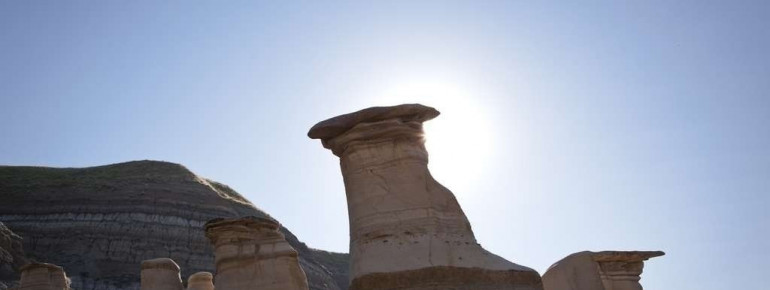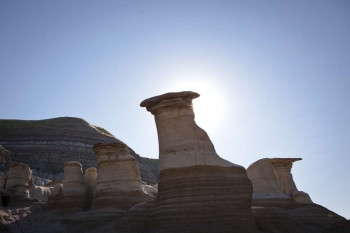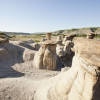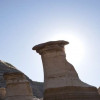Contents
Description
Beauties made of lime stone
If you want to experience Canada's stunning nature in the southwest, you're exactly right on the Hoodoo Drive. All rock formations along the way consist of lime stone and usually are between 5 and 7 metres high (16-23ft). Each and every of these rock pillars is placed on a ground entirely consisting of slate which is additionally protected by another layer of rocks. Despite of their powerful and gigantic appearance, the Hoodoos are rather fragile and can even completely collapse. Please do not climb on mushroom shaped rock formation as those are especially prone to collapse. Although many tourists do climb the narrow hill ridges of the Badlands, it is still recommended to take a look at the rock formations of the Hoodoos from underneath.
Giants in stone formation
The term “Hoodoo” is derived from the similar sounding word “voodoo”. The first Europeans to arrive here thought of the rock formations as something enchanted and weird. To the indigenous Indians from the Blackfoot and Cree tribes, on the contrary, the rock formations meant something else, something peaceful: They were petrified giants coming to life at night to throw stones on intruders. Thus, it does not come as a surprise that in the Indian culture the Hoodoos have been considered safeguards of their land up to this very day. Bearing this traditional background in mind, those extraordinary pillars make quite an impression and especially come to full effect with good weather conditions.
A highlight in any situation
The Hoodoo Drive as a sight does therefore offer many possibilities to be explored. One possibility is to just take a glance at those rock formations while driving through the area. Make sure you get as close as the road conditions allow to take amazing photographs which may turn out to be quite arty considering the special light and shade conditions on-site, making any picture a piece of art of its own. If you happen to be in the southwest of Canada, then this is a natural highlight you certainly would not like to miss.
Historical Information
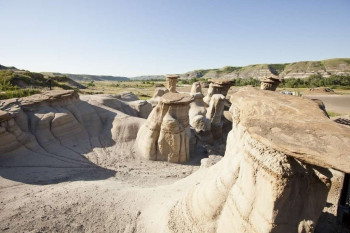
Copyright: Travel Alberta
The Hoodoo Drive is located amidst the Canadian Badlands. The entire area is predominantly characterised by arid and dry landscapes. At first, it seems to be rather remote, abandoned and, frankly speaking, does not make a spectacular impression on visitors. Originally, this impression led to the entire area being called “Mauvais Terre” by the first settlers, which literally equals the English translation of badlands.
Equally, the area is famous for its fossil finds, originating in the age of dinosaurs. Due to the fossils, especially the area around Drumheller has become a true research hub for this particular era of our earth. It is for a reason that one also finds the Royal Tyrrell Museum in the vicinity which is nowadays one of the largest research centres on this scientific field. It also exhibits a few finds of the Badlands.
Interesting facts
- Hoodoo Drive is among the 5 best rated Tourist Attractions in Canada.
How to get there
By car
The Hoodoo Drive stretches up to a length of 60km (37mi), making it a vast area. It is therefore recommended to visit the sight by car. To get here you should ideally drive in the direction of Drumheller to arrive at the beginning of the Hoodoo Drive.
From the direction of Calgary
Coming from Calgary, you first need to take the Memorial Drive towards the east. Afterwards, you continue for about 4km (2.5mi) on the Deerfoot Trail (Route 2). You take Exit 275 in the direction of Balzac/ Kathryn and keep left at the intersection to make sure you proceed to the TWP 262, which you will stay on for about 22km (13.7mi) and eventually change onto Route 9 taking you directly to Drumheller.
From the direction of Edmonton
Coming from Edmonton, you first take the Connors Road to get out of the city. You leave the first roundabout via the second exit and follow the road until you turn left onto Route 82, which eventually turns to Sherwood Park Freeway, which you now follow until you take Exit 14 leading towards Camrose/ Wainwright. This way you get to the Anthony Henday Drive (216). Follow this road for quite some time and then change to Route 14. You keep driving in the direction of Camrose on Route 21. Keep to the left to make sure you automatically enter the city centre which you will exit via Route 13 again. On the next occasion, you take a right onto Route 56 in the direction of Stettler. You cross the town and keep on this road leading you to Drumheller via Route 9.
Once in Drumheller, you'll be driving on Highway 10 for about 18km (11.2mi) leading further east. On your way, you should already be able to spot the first so-called Hoodoos. The most spectacular Hoodoos, though, are between Rosedale and a relatively small place called Wayne. To get here you just need to follow Highway 10 until Rosedale and then take a right on Highway 10X.


